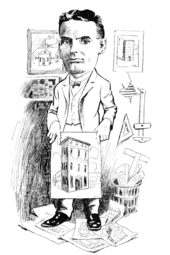Chauncey Fitch Skilling
Chauncey Fitch Skilling (1868–1945) was a Los Angeles, California, architect who was also a member of that city's school board and of its city council.

Personal
Skilling was born on December 7, 1868, in Manchester, Illinois, the son of Josiah Hamilton Skilling of Ireland and Margaret Lucy Thompson of Athens, Ohio. His brothers were Edward H., William T. and Robert P. Coming to Los Angeles in 1886, he attended Los Angeles State Normal School and the University of Southern California (1892), followed by a year at a business college (1893).[1][2][3]
He was a Presbyterian and a Republican.[1]
Residing at 1051 S. Lucerne Boulevard, he died of pneumonia at the age of 78 on February 14, 1945. Skilling was survived by brothers William T. of San Diego, California, and Robert P. of Newark, New Jersey.[2] [2]
Chief structural engineer of the World Trade Center (New York, New York), John Skilling, was a relative, the grandson of his brother Robert.
Architecture



His first recorded job was as a draftsman around 1892–94. Before going into business for himself as an architect, he was a partner of John C. W. Austin and later of Otto E. Neher.[1][2][3][4]
Skilling "designed and supervised construction of Immanuel Presbyterian Church and of dozens of other churches and schools in Southern California."[2] Some of these, either planned or completed, were:
- Residence for W. W. Richardson on Occidental Boulevard (with Otto E Neher), in an English renaissance style, "with simple lines in the design of the half timbers as well as the roof line." The lower story had a "large reception room, living rooms, library, den, dining room, kitchen and servants' room." The upper floor had four bedrooms, a dressing room and bathrooms. There was a furnace, automatic water heater and "all latest conveniences."[5]
- White glazed marble and tile building on North Broadway near Avenue 22 in Lincoln Heights, Los Angeles, (with Otto E Neher) featuring a "very pretty cupola skylight of stained glass" for the Federal Bank.,[6][7] Los Angeles Historical-Cultural Monument No. 396.
- $400,000 Auditorium Hotel, on a 60x169-foot lot on the northwest corner of Olive and Fifth Streets for oilman R.D. Wade, in modern classic design, seven stories and a basement, facing the Temple Auditorium (never built). It was planned with a lobby, a "ladies' parlor," two passenger elevators, a freight elevator and a sidewalk elevator (with Otto E Neher). There were to be 145 rooms, "hot and cold water and a bath room for every two rooms." A "modern cafe" was planned for the basement.[8]
- Three-story apartment house on Sixth Street near Burlington Avenue for L.B. Cohn, with "24 rooms divided into 45 apartments with private baths, steam heat, wall beds, vacuum cleaning system, freight elevator, plumbing and electric fixtures (with Otto E Neher).[9]
- First Presbyterian Church, Santa Monica, 1921. "The church was planned to seat 1,100 at its opening."[10]
- Bethany Lutheran Church of Hollywood, 4975 W. Sunset Boulevard, 1925. The church was dedicated on April 11, 1926. ["To Dedicate New Church" Los Angeles Times, April 10, 1926, Page A2] [11]
- Immanuel Presbyterian Church #2, Los Angeles, Los Angeles Historical-Cultural Monument No. 743[12]
Public service
Skilling served on the Board of Education in 1900-02 and was a member of the Los Angeles City Council in 1902-04.[1][13] As a councilman, in 1904 he persuaded the City Council to pass an emergency ordinance that required patients with tuberculosis and other contagious diseases to be treated in hospitals in "sections of the city that are sufficiently isolated from populous districts to minimize the danger of contamination." He said that "energetic protests" had been made against such institutions in densely populated districts."[14]
He advocated vocational training in the city schools and, with the aid of J.H. Francis, he helped pass a resolution through the City Council that resulted in the establishment of Los Angeles Polytechnic High School in 1906.[1]
References
- 1 2 3 4 5 Luella Sawyer and Clare Wallace, Los Angeles Public Library reference file, 1934 and 1937, with sources as listed there
- 1 2 3 4 5 "C.F. Skilling, Architect, Dies," Los Angeles Times, February 15, 1945, page A-2
- 1 2 Pacific Coast Architecture Database, with sources as noted there
- ↑ The dates in the sources are inconsistent.
- ↑ "Residence in English Renaissance Type Being Erected on Occidental Boulevard," Los Angeles Herald, February 7, 1909
- ↑ "North End Bank Soon to Be Built," Los Angeles Herald, May 1, 1910
- ↑ Pacific Coast Architecture Database, ID No. 5618<
- ↑ "Auditorium Hotel of Classic Style to Cost $400,000," Los Angeles Herald, July 10, 1910
- ↑ "Clubhouse to Be Built for Sons Golden West," Los Angeles Herald, November 13, 1910
- ↑ Pacific Coast Architecture Database, ID No. 4471, with sources as listed there
- ↑ Los Angeles Building permit No. 1925LA32009, issued Sept 18, 1925 lists C. F. Skilling as architect
- ↑ Pacific Coast Architecture Database, ID No. 15471, with sources as listed there
- ↑ Chronological Record of Los Angeles City Officials 1850–1938, Municipal Reference Library, March 1938, reprinted 1946
- ↑ "New Hospital Ordinance Passed," Los Angeles Herald, May 3, 1904